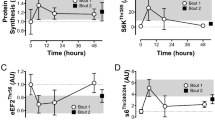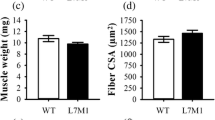Abstract
We investigated training-induced changes in biochemical properties and myosin heavy chain (MHC) composition of regenerated (cardiotoxin-injected) plantaris muscles (PLA) in rats either maintained sedentary (S, n = 9) or endurance trained on a treadmill over a 8-week period (T, n = 7). Both endurance training and regeneration altered the pattern of fast MHC expression. An analysis of the two-way interaction between training and regeneration showed that the relative content of type IIa MHC was affected (P < 0.05). The 140% increase in type IIa MHC observed in regenerated PLA from T rats compared with nontreated muscle of S rats, exceeded the 102% increase resulting from the combination of regeneration alone (26%) and training alone (61%). A similar interaction between training and regeneration was shown for the percentage of fibres expressing either type IIa or type IIb MHC (P < 0.05). In contrast, a significant increase in the citrate synthase (CS) activity was shown in PLA as a result of endurance training, without specific effect of regeneration. Furthermore, training-induced changes in CK and LDH isoenzyme distribution occurred to a similar extent in regenerated and non-treated PLA muscles, and thus did not follow the changes in MHC isoforms. An increase in the mitochondrial CK isozyme activity (mi-CK) was shown in both non-treated and previously degenerated PLA muscles (123 and 117%, P < 0.01, respectively), without specific effect of regeneration. The ratio of mi-CK to CS activity, an estimate of the mitochondrial specific activity of mi-CK was significantly increased by training (P < 0.02) and decreased by regeneration (P < 0.05). Taken together, these data suggest that while training and regeneration have cumulative effects on the pattern of fast MHC expression, the training-induced changes in the energy metabolism shown in mature non-treated myofibres are similar to those observed in regenerated fibres.
Similar content being viewed by others
References
Allbrook D (1981) Skeletal muscle regeneration. Muscle Nerve 4: 234–245.
Apple FS and Rogers MA (1986) Mitochondrial creatine kinase activity alterations in skeletal muscle during long-distance running. J Appl Physiol 61: 482–485.
Baldwin KM, Klinkerfuss GH, Terjung RL, Mole PA and Holloszy JO (1972) Respiratory capacity of white, red, and intermediate muscle: adaptative response to exercise. Am J Physiol 222: 373–378.
Bigard AX, Boehm E, Veksler V, Mateo P, Anfous K and Ventura-Clapier R (1998) Muscle unloading induces slow to fast transitions in myo®brillar but not mitochondrial properties: relevance to skeletal muscle abnormalities in heart failure. J Mol Cel Cardiol 30: 2391–2402.
Bigard AX, Janmot C, Merino D, Lienhard F, Guezennec CY and D'albis A (1996a) Endurance training affects myosin chain phenotype in regenerating fast-twitch muscle. J Appl Physiol 81: 2658–2665.
Bigard AX, Merino D, Serrurier B, Lienhard F, Guezennec CY, Bockhold KJ and Whalen RG (1996b) Role of weight-bearing function on expression of myosin isoforms during regeneration of rat soleus muscles. Am J Physiol 270: C763-C771.
Booth FW and Thomason DB (1991) Molecular and cellular adap-tation of muscle in response to exercise: perspectives of various models. Physiol Rev 71: 541–585.
Couteaux R, Mira JC and D'albis A (1988) Regeneration of muscles after cardiotoxin injury. I. Cytological aspects. Biol Cell 62: 171–182.
Cossu G and Molinaro M (1987) Cell heterogeneity in the myogenic lineage. Curr Top Dev Biol 23: 185–208.
D'albis A, Couteaux R, Janmot C, Roulet A and Mira JC (1988) Regeneration after cardiotoxin injury of innervated and denervated slow and fast muscles of mammals. Myosin isoform analysis. Eur J Biochem 174: 103–110.
Devor ST and White TP (1996) Myosin heavy chain of immature soleus muscle grafts adapts to hyperthyroidism more than to physical activity. J Appl Physiol 80: 789–794.
Donovan CM and Faulkner JA (1987) Plasticity of skeletal muscle: regenerating fibers adapt more rapidly than surviving fibers. J Appl Physiol 62: 2507–2511.
Fitzsimons DP, Diffee GM, Herrick RE and Baldwin KM (1990) Effects of endurance training on isomyosin patterns in fast-and slow-twitch skeletal muscles. J Appl Physiol 68: 1950–1955.
Harris JB, Johnson MA and Macdonell CA (1980) Muscle necrosis induced by some presynaptically active neurotoxins. In: Eaker D and Wadstrom T (eds) Natural Toxins. (pp. 569–578) Oxford, Pergamon Press.
Lefaucheur JP and Sebille A (1995) The cellular events of injured muscle regeneration depend on the nature of the injury. Neuromusc Disord 5: 501–509.
Nemeth PA, Cope TC, Kushner S and Nemeth PM (1993) Spatial arrangement and metabolic capacity of ®ber types in self-reinner-vated cat muscle. Am J Physiol 264: C411-C418.
Roy RR, Eldridge L, Baldwin KM and Edgerton VR (1996) Neural infuence on slow muscle properties: inactivity with and without cross-reinnervation. Muscle Nerve 19: 707–714.
Russell SD, Cambon NA, Nadal-Ginard B and Whalen RG (1988) Thyroid hormone induces a nerve-independent precocious expres-sion of fast myosin heavy chain mRNA in rat hindlimb skeletal muscle. J Biol Chem 263: 6370–6374.
Schiaffino S, Gorza L, Sartore S, Saggin L, Ausoni S, Vianello M, Gundersen K and Lùmo T (1989) Three myosin heavy chain isoforms in type 2 skeletal muscle fibres. J Muscle Res Cell Motil 10: 197–205.
Schmitt T and Pette D (1985) Increased mitochondrial creatine kinase in chronically stimulated fast-twitch rabbit muscle. FEBS Lett 188: 341–344.
Snoj-Cvetko E, Sketelj J, Dolenc I, Obreza S, Janmot C, D'albis A and Erzen I (1996) Regenerated rat fast muscle transplanted to the slow muscle bed and innervated by the slow nerve, exhibits an identical myosin heavy chain repertoire to that of the slow muscle. Histochem Cell Biol 106: 473–479.
Spencer RGS, Buttrick PM and Ingwall JS (1997) Function and bioenergetics in isolated perfused trained rat hearts. Am J Physiol 272: H409-H417.
Srere PA (1969) Citrate synthase. Methods in Enzymology 13: 3–11.
Sullivan VK, Powers SK, Criswell DS, Tumer N, Larochelle JS and Lowenthal D (1995) Myosin heavy chain composition in young and old rat skeletal muscle: effects of endurance training. J Appl Physiol 78: 2115–2120.
Talmadge RJ and Roy RR (1993) Electrophoretic separation of rat skeletal muscle myosin heavy-chain isoforms. J Appl Physiol 75: 2337–2340.
Ventura-Clapier R, Veksler V and Hoerter JA (1994) Myofibrillar creatine kinase and cardiac contraction. Mol Cell Biochem 133: 125–144.
Vivarelli E, Brown WE, Whalen RG and Cossu G (1988) The expression of slow myosin during mammalian somitogenesis and limb bud differentiation. J Cell Biol 107: 2191–2197.
Whalen RG, Harris JB, Butler-Browne GS and Sesodia S (1990) Expression of myosin isoforms during notexin-induced regenera-tion of rat soleus muscles. Dev Biol 141: 24–40.
Yamashita K and Yoshioka T (1992) Activities of creatine kinase isoenzymes in single skeletal muscle fibers of trained and untrained rats. PfÜgers Arch Eur J Physiol 421: 270–273.
York JW, Oscai LB and Penney DG (1974) Alterations in skeletal muscle lactate dehydrogenase isozymes following exercise training. Biochem Biophys Res Commun 61: 1387–1393.
Author information
Authors and Affiliations
Rights and permissions
About this article
Cite this article
Bigard, A.X., Mateo, P., Sanchez, H. et al. Lack of coordinated changes in metabolic enzymes and myosin heavy chain isoforms in regenerated muscles of trained rats. J Muscle Res Cell Motil 21, 269–278 (2000). https://doi.org/10.1023/A:1005680921792
Issue Date:
DOI: https://doi.org/10.1023/A:1005680921792




